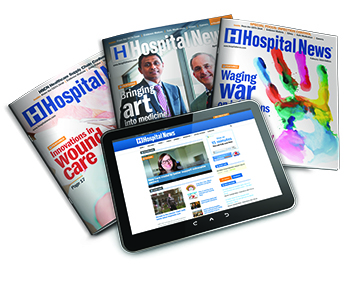Carse Harman has had eight appointments with Royal Victoria Regional Health Centre (RVH) oncologist Dr. Bryn Pressnail, but has only seen him in person twice. That’s just fine with him. No slight against Dr. Pressnail, Harman just hates to travel. The thought of having to drive to Barrie from Muskoka for his medical appointments was adding stress to an already stressful situation.
Instead, Harman, 60, is able to meet with the Barrie oncologist without leaving his hometown of Huntsville. He does this through the Ontario Telemedicine Network (OTN). Telemedicine uses two-way video-conferencing and accompanying diagnostic equipment to provide medical consultation. “That’s huge for me,” says Harman, who was diagnosed with lung cancer in December. “I live 10 minutes away from my local hospital. I come here and have my visits with Dr. Pressnail through telemedicine and then head home. I’m done in less than 40 minutes. It would take me an hour and half just to get to Barrie. That’s one way and providing the weather isn’t too bad.”
MORE: GAME CHANGERS: TOP 10 HEALTH TECHNOLOGIES FOR 2015
Often the weather is bad and in the summer the traffic can be brutal. Last year Environment Canada issued 44 severe weather warnings in Simcoe-Muskoka and on long weekends over 125,000 cars snarl traffic on Highway 400. “It is a big relief for us,” says Holly Chantler, Harman’s wife. “It’s so stressful having to drive to Barrie – we know because we had to do it for three days in a row for the first appointments. We were so stressed out. It was snowy and stormy. You just never know what kind of weather you will hit on the way there or back. Telemedicine alleviated the unknown of travel and weather. When you are dealing with cancer there are enough unknowns – this just eliminates one of them.”
Last year at RVH, 2,600 patient “visits” took place via telemedicine. This amounts to more than 700 clinic hours and saves patients more than 400,000 km of travel. “Telemedicine is so patient friendly. Sometimes, at first, they are a little nervous because it is new and they are not used to being on television, but after the first session it is like we are both in the same room together,” says Dr. Pressnail. “Telemedicine saves my patients travel time, provides them care close to home, and for many, it reduces the financial burden of gas, parking and meals they would have to face if travelling for these appointment. What is good for my patients is good for me.”
Dr. Pressnail has been such an avid supporter of telemedicine that he is among the first to receive a Champion of Telemedicine Award from the Ontario Telemedicine Network. He is recognized for his leadership in the development, testing and implementation of telemedicine which continues to improve care for his patients every day. “Dr. Pressnail has been an amazing advocate for his patients throughout his entire career. He was one of the first physicians to champion this new technology because he could see that it would have a huge, positive impact in the lives of his patients. And he was right,” says Lindsey Crawford, RVH vice-president, Patient Programs and regional vice-president, Cancer Care Ontario.
MORE: “DO YOU DO THAT LAPAROSCOPICALLY?”
Dr. Pressnail began holding telemedicine appointments in 2011, but only in limited numbers. Now it is a daily routine for 20 cancer doctors (radiation oncologists, medical oncologists and gynecological oncologists) at RVH’s Simcoe Muskoka Regional Cancer Centre (SMRCC) to see at least three patients every day via telemedicine. If OTN didn’t present Dr. Pressnail with an award for such leadership, you can bet Carse Harman would have. “The only problem I have with this service is that it has saved me so much time I don’t know what to do with myself. There’s only so many soap operas I can watch,” laughed Harman.




